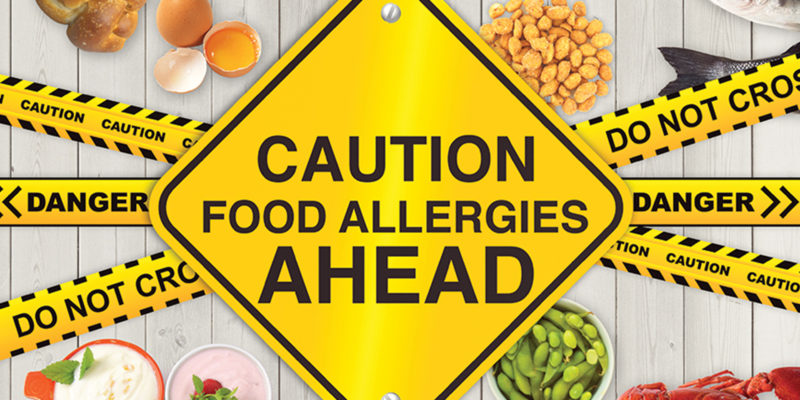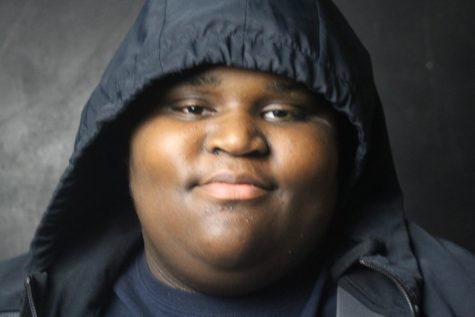Allergy Awareness
For people who don’t have food allergies they may not know about the precautions that people with allergies have to take in their daily lives
Junior Cassidy Guimont was running at cross country practice last year when she noticed she was struggling. Something had been affecting how she was performing in her races lately. She went to the doctor to figure out what was wrong. The doctor sent her to get some blood work done because they suspected it was anemia. However, when the test came back, she found out she had celiac, an immune disease where people cannot eat gluten.
“My initial feelings were scared and nervous for what it meant. I didn’t know how I would adjust my life and diet, so the unknown made me worried,” Guimont said.
Guimont is just one of about 70 students at LN affected by food allergies, according to LN nurse Valerie Gelwicks. According to the Food Allergy and Research Education, food allergies affect 1 in 13 children in America, and there are more than 170 foods that have been reported to cause allergic reactions. These food allergies can range from a minor discomfort to a life threatening emergency. The nurses are responsible for informing the cafeteria and any other necessary people about a student’s allergy for their safety. In addition, families and doctors create a care plan in order to inform the nurses how their students are to be treated.
“We have to notify the cafeteria workers of the kids that have known food allergies so that they can know if they’re giving them the wrong food and can guide them to the right food,” Gelwicks said.
Gelwicks added that they also ask students who have known food allergies to submit a care plan from their doctors so the nurses and school can know how to treat any kind of reaction they might have from those food allergies.
“If they have severe, life-threatening reactions, we ask that they send in emergency medication, usually like an epipen that some of the time, we keep it in the clinic, some of the time they carry it themselves depending on how the doctor wants it done,” she said.
The system in the cafeteria is built to notify cafeteria workers of an allergy a student has before they purchase their food to ensure that they aren’t going to eat anything that could possibly cause a reaction.
“If they put in their lunch number, it’ll come up on the register what they are allergic to. They always double check their food. If it says no tree nuts, they make sure whatever they have on their tray does not have any tree nuts in it,” cafeteria manager Patti Musgrove said.
For people like junior Nicholas Langham, their allergies are so severe that they have to be isolated during lunch time to ensure that they don’t have any cross contamination that would cause an attack. Although he does not have to sit at a seperate table now, Langham had to sit at a peanut-free table in elementary school away from the rest of the cafeteria. Although he was isolated, he had some friends that would pack peanut-free lunches so that they could still sit with him at lunch time while keeping him safe.
“In elementary school, we had a peanut free table. I mean, most of the time, it was fine because my friends would come and sit with me so it wasn’t like I was being separated because they would sit with me because they knew that I couldn’t sit with them,” Langham said.
Many allergies can be inherited from one’s parents. This means people with allergies have the potential to pass on this trait to their children. For journalism teacher Sarah Jamerson, who has a shellfish allergy, this means her son, Lawson, has the potential to also have the same allergy. Before he can be diagnosed with a shellfish allergy, he will have to be tested at a doctor’s office once he is old enough in order to test for allergic reactions.
“What we have learned is that shellfish is a genetic allergy, so with my children, Lawson isn’t allowed to have it yet because of my allergy. We have to allow him to get to a certain point and then we’ll test him for it to make sure he is safe in a doctor’s office,” Jamerson said.
Despite all the precautions they take, sometimes attacks do happen and the school has to be prepared to treat them with medication, like an epipen. An epipen is a spring loaded syringe that is filled with epinephrine which is the only effective treatment once a serious attack begins. Langham carries an epipen on him just to be prepared for an attack.
“I haven’t had [an attack] in 15 years or something. I do [carry an epipen],” Langham said.
When a student has an attack at school, the nurse will administer an epipen to help stop the attack. Then, the student will be taken to the hospital and monitored to make sure they don’t get worse.
“Well, they’ll come in here and they’ll be maybe complaining, ‘Hey, I ate this cookie that this kid gave me and I didn’t think to ask whether it had nuts in it or not’, and they’re like, ‘My throat’s feeling really weird,’ and then their pulse is high. So we grab our epipen and we give that to them and they’re better just like that. It’s amazing. And then we have to call the ambulance and send them to the hospital because it wears off and then they might need another dose. It’s required that we send them by ambulance,” Gelwicks said.
According to Indiana Law 245, school nurses can administer an epipen prescribed by a healthcare provider to students, school personnel, and visitors to the school that are exhibiting signs or symptoms of life-threatening anaphylaxis. Lawrence Township has installed safe boxes to keep emergency epipens and asthma medications prescribed by Community Health Network. Gelwicks believes that this can be useful for people who forget to bring their epipen with them or who do not know they have a food allergy.
“Even at your age, you can still develop an allergy. It’s not as common, but it is possible. We had a student earlier this year that started breaking out in hives and having throat issues, and we had to use our emergency epipen. If we can identify if the kid’s got obvious allergic symptoms and is starting to not be able to breath, we are covered by the standing order from this doctor to use that epipen,” Gelwicks said.
In order to prevent potential attacks from cross contamination, many people with food allergies have to have their food prepared separately at restaurants. For Jamerson, this means preparing her food on a separate grill especially at restaurants that serve seafood.
“In restaurants where they have seafood and especially shellfish readily available, I have to specifically order mine separately. The place I noticed it the most is hibachi restaurants because when you sit at that table and they cook everyone’s food on that and they’re throwing shrimp around, they have to go cook mine back in the kitchen and bring it out separately,” Jamerson said.
Guimont works at Sundae’s Homemade Ice Cream and understands the precautions they have to take to keep people safe. The employees have to memorize a list of gluten free flavors in case someone asks about it. They also have to clean the scoops to make sure there is no cross contamination.
“At work, we have a list of all the gluten free ice cream flavors and as workers, we’re supposed to be educated in them. So kind of like, when you start working there, you kind of like just have to memorize it because you have to be able to answer questions and we also wash the scoops if somebody’s used them,” Guimont said.
In the cafeteria, the workers have to prepare food separately for students with extreme allergies. This is to make sure there is no cross contamination in the student’s food.
“If we are notified that a student has an extreme allergy which the nurse will let us know if we have somebody extremely allergic, we make sure their food is prepared separately,” Musgrove said.
Despite this, sometimes cross contamination can still happen if something is not cleaned as well as it should be. Jamerson can usually tell when this is the case because the small amount that ends up in her food ends up making her ill.
“I’m always aware when restaurants don’t clean their counters and their surfaces because if my food touches it, I get sick to my stomach and I can always tell,” Jamerson said.
Gluten is a chemical that can soak into containers cause contamination even after they have been washed. For Guimont, this means that she has to keep her own containers and dishes separate from the rest of her family in order to prevent cross contamination.
“We have a cabinet of my containers because of cross contamination. Can’t have cross contamination which is a struggle. So we have my toaster and then the family’s toaster, so that kind of stuff. And like, my dishes and their dishes. My containers and their containers. Like that separate stuff, so that’s pretty much it,” Guimont said.
Guimont can find gluten free options at most restaurants she eats at with how common the allergy is becoming. However, many fast food places have not started to offer these options yet which can make it difficult for her to find something to eat when she eats out.
“Most places, like restaurants have gluten free options but it’s hard because restaurants like Steak’n Shake or McDonalds, mainly fast food restaurants don’t have options so it’s harder to just grab a bite to eat. So just going out to eat is pretty difficult sometimes,” Guimont said.
Jamerson hopes that people will begin to understand the severity of allergies and the effects they can have on people affected by them. She believes that restaurants need to make it easy for people to order what they can and can’t have in order to help protect customers from having potential reactions.
“I think that what people need to know is that we’re not making it up. It really messes with our systems and can really ruin your day if you come in contact with something your body doesn’t like. Making it as easy as possible for people to say what they want and don’t want is the solution here,” Jamerson said.
Langham has noticed difficulty in finding safe food to eat when he is at a friend’s house who is not aware of his allergy or just doesn’t remember. He hopes that people’s awareness of allergies grow and that they learn to communicate in order to make sure they are serving safe food.
“[I would like] having something to remind people other than me having to get their attention to tell them because I’ll go to parties and I can’t have cake and just being able to tell them a lot easier to communicate that,” Langham said.
Guimont hopes that people will begin to view allergies as something normal. She feels that right now people tend to view her as complicated because she has to order her food with a special bun, salad without croutons, or in other ways because of her allergy.
“[I wish people would view it as] just like, as normal. Like, not considered complicated at restaurants like I have a complicated order, and it’s like, ‘no, it’s just I’m different than other people.’ So I just wish that like people would be more accepting and not get annoyed like you have to alter stuff and people think you’re complicated or complex, so that’s kind of annoying. If you’d live this life, you’d understand,” Guimont said.
Despite the challenges that come with celiac, Guimont would not change her disease. She has learned to live with it and it has become a regular part of her life now.
“I wouldn’t change it because it’s a part of me now and it makes me unique,” Guimont said.













